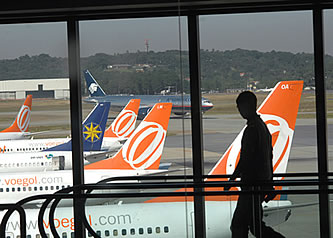By David Gold
April 18 – Up to 10 of the 13 Brazilian airports currently being upgraded for the 2014 World Cup, are unlikely to be ready on time or able to cope with the volume of air traffic during the tournament, a report by the country’s Institute for Applied Economic Research shows.
Brazil has been tormented by problems in its preparations for the tournament, with various issues affecting the construction of stadiums.
The Maracana in Rio de Janeiro is undergoing renovation and needs a new roof, potentially delaying its completion.
And neither of the stadiums scheduled to be built in Natal or Sao Paulo, which is intended to host the tournament’s opening game, have even begun construction.
The situation is made worse in Natal as work on an airport has yet to begin in the city, which paints a horrifying picture for one of the tournament’s main venues.
And in Sao Paulo, it will have to significantly improve infrastucture to meet demand during the World Cup as it currently handles 25 per cent of the country’s air traffic.
The report said that to meet air traffic requirements, Brazil needed “a greater allocation of resources in response”.
“This points to the need for urgent improvement in the management of the Infraero [the company carrying out the airport construction in the country] business,” the report continued.
Most scathing though, is its assessment of the projected operation capacities of the country’s main airports.
“Of Brazil’s largest 20 airports, 14 airports operated above 100 per cent capacity, indicating a critical situation.
“That meant an average occupancy rate for these 14 terminals of 187 per cent.
“Only three terminals are in an appropriate situation in terms of capacity utilisation.”
To deal with the problems, Infraero, which controls 97 per cent of the country’s air traffic and 67 airports, has budgeted $2.2 billion (£1.4 billion) over the next three years in order to complete upgrades to 13 airports to prevent them having to operate over capacity.

Brazil’s economy is rapidly increasing, creating new wealth which is attracting an increasing number of visitors to the country, exacerbating the problem.
Giovanni Bisignani, the chief executive of the International Air Transport Association, spelled out this inconsistency lucidly last month at a conference in London.
“Brazil’s GDP is the eighth largest, but its international aviation market, with just 13 million passengers, ranks 37th – below Indonesia and Norway,” he said.
“This is disproportionate to Brazil’s size and importance on the world stage.”
McKinsey points out that Brazil’s airline passenger numbers have increased from 68 million in 2000 to 113 million in 2008.
Brazil is already experiencing problems, with flight delays and cancellations frequent across the country.
With the Rio de Janeiro Olympic Games coming up in 2016, meaning Brazil hosting the world’s two most popular sporting events in the space of two years, the increased demand of the coming years underlines the urgency of completing the airport upgrades in time.
Contact the writer of this story at zib.l1745207397labto1745207397ofdlr1745207397owedi1745207397sni@d1745207397log.d1745207397ivad1745207397
Related stories
April 2011: Blatter satisfied with Brazil 2014 progress
April 2011: Maracana gets green light for new roof
April 2011: Brazil 2014 World Cup draw to be held in Rio de Janeiro
April 2011: Maracana to need new roof whilst new Manaus stadium enters second construction phase
March 2011: Exclusive – Two Brazil 2014 World Cup stadiums in “critical situation” warn FIFA

